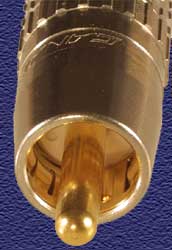
hdmi - component video - s-video - rgbhv - rf - composite - a/v - dvi
digital audio - stereo audio - multichannel audio - balanced audio - subwoofer - speaker - adapters
Subwoofer Cables
--View our Subwoofer Cable Price List--
The Coax: Canare LV-77SCanare LV-77S is a flexible, but thick coax with a stranded copper center conductor and two bare copper braid shields, one right on top of the other. This shielding provides an extremely conductive path to ground--just 1.8 ohms per thousand feet, lower than any other coax of comparable size. We put this cable up against a whole slate of other coaxes in a side-by-side hum rejection test, and it performed best of all. It is thick--.303 inch in diameter--but is more flexible than other comparably-sized coaxes, and therefore easy to route around obstacles if you're doing in-wall or in-conduit cabling. View Canare's description and technical specs for LV-77S.
We hand-cut and terminate each of these cables ourselves, using Canare tooling, so we know they're done right and tested before they go out. We think you'll be impressed with their performance; but we also offer a complete, unconditional return privilege. If for any reason--or for no reason--you're not completely, utterly satisfied, just return the cables within 30 days and we'll refund your purchase price in full. Alternatives and Add-ons:In addition to our standard Canare LV-77S/Canare RCAP configuration, we can supply the following options:Other coaxes:We carry a variety of coaxial cables from which we can make subwoofer cables. A few are listed below; for a complete list, click here.Belden 1505F:Belden 1505F, also a double-braid shielded cable, was a close runner-up to LV-77S in our hum tests, and is both more flexible and less expensive; in most applications, where EMI noise is not extreme, we would not expect any performance difference between the two, and so we can heartily recommend 1505F as an alternative cable for subwoofer use. View the technical specs for Belden 1505F. Belden 1695A Coax:Belden 1695A is a Teflon-dielectric cable, fire-rated for use in a plenum (e.g., a dropped-ceiling space used as a ventilation return). Its braid/foil shielding provides excellent hum rejection, and 1695A is our best plenum cable for subwoofer use; if you don't need a plenum-rated cable, however, the hum rejection characteristics of both LV-77S and 1505F are superior. View Belden's specs for 1695A. Calrad Isolation Transformer:There are two primary reasons why an otherwise healthy subwoofer may hum, and cables can deal only with one of these: EMI. The other possibility, a ground loop, is something your cables can't fix, and has to do with differences in ground potential in your system's power wiring. Although the best and most permanent way to eliminate ground loop hum is by fixing the underlying grounding problem, another simpler way to resolve the problem is to insert an isolation transformer in your subwoofer line to break the ground connection between your source and your subwoofer. We carry a small isolation transformer for this purpose, from Calrad, for $25.00. Y-adapters:Some subwoofers function best with the signal fed not to one, but two, inputs--if you're in doubt about whether to feed signal to one or to two inputs, consult the manual for your subwoofer. We offer two different adapters to split the signal from a single output to more than one sub input; the most often-used type is our short Y cable, with one female end and two male ends, made for us by AVLink. This is a well-built, braid-and-foil shielded cable, about one foot long, and sells for $15.00. Alternatively, we also carry a small plastic hardshell adapter with one male and two female connections; this is useful if you're daisy-chaining subs together or jumpering from one sub input to another, but necessitates using another cable to make the jumper connection, and is $2.50. Our Subwoofer Cable Price ListOur other departments:
Back to Main Store Page |
















